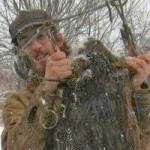Garden Experiments
The layered compost experiment has done very well for us in the garden. Plans are to expand it now, for next year. I brought up a round bale tonight and plan on rolling it out and wetting it down. I'm going to mix the layers of hay with chicken manure, composted cow manure, wood ashes and perhaps some peat. This heavy mulch, topsoil building gardening is the answer for our hill country soil. By using round bales and things I have a lot of on the farm, I should be able to make fairly big spot with limited work and expence. One of the best things about it, is the fact that you don't have to till it at all. Makes spring planting go lickity split.
Another thing that worked real well this year was the wide rows of beans. I'll never bother planting single or double rows again. They really did well, in part becouse of the shad canopy that they made for the roots. The ground didn't dry out as quick and there were hardly any weeds at all. I planted them very thick, I was afraid to thick, but they yeilded very well. My widest row was 4 ft. This may be about as wide as I'd make them, for ease of picking.




1 Comments:
I plant bush beans in intensive 4ft. wide beds and find I get very high yields. The plants are cheek-by-jowl (only about 3-4 inches apart). In fact, I am no longer going to grow pole beans because the bush beans are yielding more produce per square foot.
We use a lot of dried beans so next year, I am going to plant more beans that are better suited for those recipes, like Anasazi beans. It is much easier than canning as well. Just let them dry on the vine.
Good to hear that you like the lasagna method. I am strongly considering going that route next year. I have been collecting extra lawn clippings and will gather all of the leaves that I can this fall. Just remember to add some lime (if you don't have enough ashes), since all of the straw, hay, peat, etc usually adds acidity.
Post a Comment
<< Home